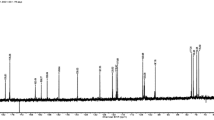Abstract
Phytochemical investigation of the whole plants of Crotalaria sessiliflora L. led to the isolation of four flavonoids. The structures of these compounds were identified as 2′,4′,5,7-tetrahydroxyisoflavone (1), 2′,4′,7-trihydroxyisoflavone (2), 4′,7-dihydroxyflavone (3), and isovitexin (4) using spectroscopic analysis. Among these, compounds2, and3 have not been reported from.Crotalaria species, whereas compounds1, and4 were reported from this plant for the first time.
Similar content being viewed by others
References
Agrawal, P. K. and Bansal, M. C., Isoflavonoids, Agrawal, P. K. (Eds.).In Carbon-13 NMR of Flavonoids. Elsevier, Amsterdam, pp. 183–235 (1989a).
Agrawal, P. K. and Bansal, M. C., Flavonoid glycosides, Agrawal, P. K. (Eds.).In Carbon-13 NMR of Flavonoids. Elsevier, Amsterdam, pp. 283–364 (1989b).
Biggs, R., Post-infectional compounds from the French beanPhaseolus vulgaris: Isolation and identification of genistein and 2′,4′,5,7-tetrahydroxyisoflavone.Aust. J. Chem., 28, 1389–1392 (1975).
Huang, L., Wu, K.-M., Xue, Z., Cheng, J.-C., Xu, L.-Z., Xu, S.-P., and Xi, Y.-G., The isolation of antitumor active principle ofCrotalaria sessiliflora and synthesis of its derivatives (authors transl).Yao Xue Xue Bao (Acta Pharmaceutica Sinica), 15, 278–283 (1980). (cf. Chem. Abstr., 95, 43427, 1981)
Kim, T. J., Korean Resources Plants, Vol II, Seoul National University Press, Seoul, p.251 (1996).
Lane, G. A. and Newman, R. H., Isoflavones fromLupinus angustifolius rootPhytochemistry, 26, 295–300 (1987).
Markham, K. R., Techniques of Flavonoid Identification, Academic Press, London, pp 86–90 (1982).
Markham, K. R. and Chari, V. M., Carbon-13 NMR spectroscopy of flavonoids, Harborne, J.B. and Mabry, T.J. (Eds.).In The Flavonoids: Advances in Research. Chapman & Hall, London, pp. 129–132 (1982).
Markham, K. R. and Geiger, H.,1H nuclear magnetic resonance spectroscopy of flavonoids and their glycosides in hexadeuterodimethylsulfoxide. Harborne, J. B. (Eds.).In The Flavonoids: Advances in Research Since 1986. Chapman & Hall, London, pp. 441–497 (1994).
Roder, E., Liang, X. T., and Kabus, K. J., Pyrrolizidine alkaloids from the seeds ofCrotalaria sessiliflora.Planta Med., 58, 283 (1992).
Shirataki, Y., Yokoe, I., and Komatsu, M., Two new flavone glycosides from the roots ofSophora subprostrata.J. Nat. Prod., 49, 645–649 (1986).
Woodward, M. D., Phaseollin formation and metabolism inPhaseolus vulgaris.Phytochemistry, 19, 921–927 (1980).
Author information
Authors and Affiliations
Corresponding author
Rights and permissions
About this article
Cite this article
Yoo, H.S., Lee, J.S., Kim, C.Y. et al. Flavonoids of crotalaria sessiliflora. Arch Pharm Res 27, 544–546 (2004). https://doi.org/10.1007/BF02980129
Received:
Issue Date:
DOI: https://doi.org/10.1007/BF02980129




